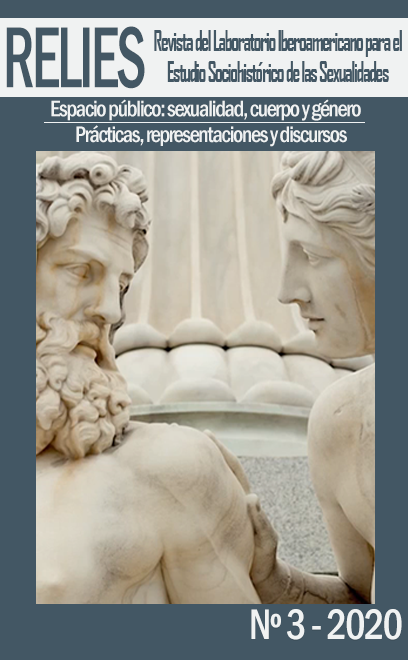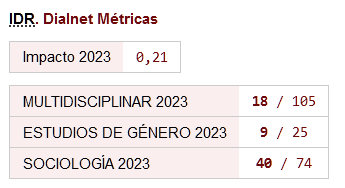Bodies, signs and spaces: about panoptic architecture of urinary segregation
DOI:
https://doi.org/10.46661/relies.4904Keywords:
Bodies, Segregation, Binarism, Panopticon, GenAbstract
The question to begin: How is it possible to think dynamic interceptions between bodies, signs and spaces? Introduction presents, Foucault, Halperin and Witting dialogue exercise in order to clarify that sexuality device is heterogeneous in its heterogeneity of displays. The second part briefly describes the genealogy of the elaboration of techno-gender concept within transfeminism. This allows to build a lectern to enable the thinking of heteronormative sexuality device, configured by somatopolitic fictions held in segregative categories, which bases are devices verification, body techniques, government regimes, and architectural designs of spaces, where binary gender (Men/Women) is the effect of technologies that produce contextually situated subjects. The third part axis is the study of Foucalt’s panopticon in Guard and punish; with some ideas of Lacan, Allouch and Preciado to argue why panoptic surveillance of genders is considerate urinary segregation. Conclusion gathers ideas about segregation problem whose basis is binary thinking, with the invitation to approach the minority befall of bodies and the critical study of the scientific-technical discourses of modernity.
Downloads
References
Allouch, J. (1991). Un sexo o el otro Sobre la segregación urinaria. Litoral n°11/12, 7-37.
Allouch, J. (2009). El sexo del Amo. El erotismo desde Lacan. Argentina: Cuenco de Plata.
Allouch, J.. (2018). Para acabar con una versión unitaria de la erótica. Dos analíticas del sexo. México: Epeele.
Bercovich, S. (2010). La zona gris. Me cayó el veínte. N° 22 Conocido el Otro... ¿de veras?, 107-126.
Bentham, J. (1979). El Panóptico. España: La Piqueta.
De Lauretis, T. (1996). La tecnología del género. Mora, núm. 2, 6-34.
Foucault, M. (1966). El nacimiento de la cínica. México: Siglo XXI.
Foucault, M . (1976). Vigilar y castigar. El nacimiento de la prisión. México: Siglo XXI.
Foucault, M . (1977). Historia de la sexualidad 1. La Voluntad de Saber. México: Siglo XXI.
Foucault, M . (1990). Tecnologías del yo Y otros textos afines. España: Paidós.
Halperin, D. (2000). ¿Hay una historia de la sexualidad?. En Grafías de Eros (págs. 21-51). Buenos Aires: Edelp.
Halperin, D. (2004). San Foucault. Para una Hagiografia Gay. Argentina: Cuenco de Plata.
Lacan, J. (1992). El Seminario, Libro 17. El reverso del psicoanálisis. Argentina: Paidós.
Lacan, J . (2009). La Instancia de la letra en el inconsciente o la razón desde Freud [1957]. En J. Lacan, Escritos 1 (págs. 231-309). México: Siglo XXI.
Preciado, P. B. (2008). Testo Yonqui. España: Espasa Calpe.
Preciado, P. B. (2009). Basura y Género. Mear/Cagar. Masculino/Femenino. Recuperado el 20 de julio de 2018, de Parole de Queer 2: https://www.scribd.com/fullscreen/79994784?access_key=key-1kzk7tzxrj9solcq2esc
Putnam, H. (1988). Razón, Verdad e Historia. España: Tecnos.
Rajchman, J. (2001). Lacan, Foucault y la cuestión de la ética. México: Epeele.
Roudinesco, É. (2010). Nuestro lado oscuro Una Historia de los perversos. México: Anagrama.
Valencia, S. (2016). Transfeminismo(s). En H. Moreno, & E. Alcántara (Coordinadoras), Conceptos clave en los estudios de género. Volumen 1 (págs. 327-337). México: UNAM.
Wittig, M. (2006). El Pensamiento Heterosexual y otros ensayos. España: Egales.
Downloads
Published
How to Cite
Issue
Section
License
Copyright (c) 2020 Creative Commons 4.0 Internacional

This work is licensed under a Creative Commons Attribution-NonCommercial-NoDerivatives 4.0 International License.






